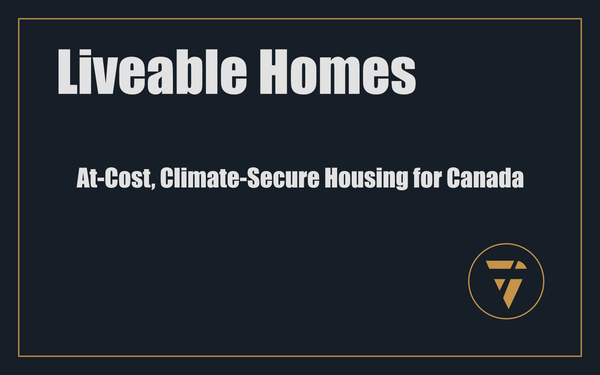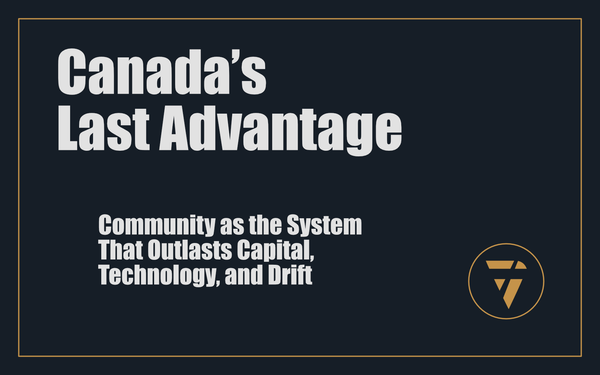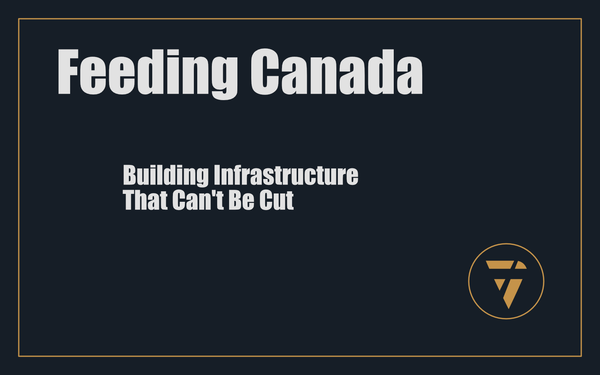What Comes After Capitalism On Life Support?

A conversation with Carrie, and a map for the rest of us
It started with a single, piercing question.
Carrie — clear-eyed, unflinching — laid it down like a gauntlet:
"Well okay - the oligarchs or whomever are still controlling the narrative. If the decline is inevitable, are you advocating acceptance of tyranny or a communist uprising or just plain old anarchy? What do you think would be better than capitalism on life support?"
This isn’t rhetoric. This is the real question.
Under every news cycle, every protest sign, every institutional press release and every whispered “nothing’s going to change,” lies the same quiet panic: if this isn’t working, what comes next?
So let’s answer. Not with theory. With clarity. With architecture.
Let’s break the trance.
I. THE ILLUSION OF CHOICE
In 2025, political imagination has been surgically removed from public discourse. What we’re offered is not a spectrum, it’s a hallway. One end marked "collapse," the other "control." And we are told to walk quietly between them.
Tyranny or chaos.
Elite rule or mob rule.
Technocratic sedation or populist fire.
Every time someone calls the system into question — from the left or right — the same weapons are deployed: fear of revolution, fear of regression, fear of being worse off than now.
But here’s the truth Carrie cracked open: those aren’t real options. They’re the decoys. Installed to keep us from asking the only question that matters:
If capitalism is dying — what are we building in its place?
Not burning. Not surviving.
Building.
II. THE FALSE GOD OF CAPITALISM
Capitalism was never meant to be a religion. It was a mechanism. A way to channel human ambition into productivity. And for a while, it worked. Sort of.
But what we call capitalism now isn’t capitalism at all.
It’s monopoly.
It’s data feudalism.
It’s financial alchemy divorced from real-world value.
It’s institutional capture, offloaded risk, and moral liability as a business model.
It’s capitalism without consequence, for those at the top.
And for everyone else?
Stagnant wages. Disappearing housing. Surveillance as service. Education as debt. Mental health as a subscription. Retirement as a myth.
This is not capitalism. It’s what happens when capitalism refuses to evolve.
And like every unadaptive system before it, it’s entering its fossil stage.
But systems don’t end on their own. They ossify until someone builds the replacement.
III. WHAT WE ARE NOT ADVOCATING
Let’s be precise. Because vague revolution is a fast track to ruin.
We are not advocating tyranny.
Authoritarianism thrives in chaos. It seduces a tired population with the promise of order. But order without accountability is just polished violence. Every regime that promised “stability” at the cost of participation has delivered disaster.
We are not advocating communism.
We don’t need more central control. We don’t need a new class of bureaucratic gods deciding the fate of millions. We’ve seen what planned economies produce: suppression of innovation, stagnation of spirit, and the death of dissent.
We are not advocating anarchy.
Collapse is not freedom. A broken state is not a liberated one. When structure dissolves and no alternative exists, the worst actors take the stage. That’s not theory, it’s history. Power vacuums do not stay empty for long.
So... no to revolution-as-spectacle.
No to anti-capitalism as a vibe.
No to romanticising collapse.
Carrie was right to ask the question. Because the answer must be something built. Not merely against something, but for someone.
IV. THE THIRD PATH: CONSTRUCTION
What we advocate is not reaction. It’s replacement.
Not ideology. Infrastructure.
Call it what you want — post-capitalism, civic economics, regenerative enterprise — the name doesn’t matter yet. What matters is that it’s built on principles the current system cannot embody:
- Distributed Ownership: Not just wages. Not just benefits. Real participation in value creation. Shared upside.
- Embedded Accountability: Every entity, from platform to parliament, must be transparent by design, not by request.
- Decentralised Leverage: Not a flat world. But a federated one. Local control. Networked intelligence. Permissionless participation.
- Value Over Extraction: Build systems that reward those who generate value, not those who merely intermediate it.
And above all: consequence attached to power. You touch the system, you bear its outcomes. No more outsourcing risk while hoarding reward.
This isn’t a manifesto. It’s a build order.
V. WHAT IT LOOKS LIKE IN PRACTICE
Let’s ground it.
1. Business as Architecture
New models are emerging now. Co-operatives with revenue splits embedded into code. Fractional ownership platforms giving creators, workers, and users equity from day one. Contracts that self-execute payouts based on contribution, not hierarchy.
The gig economy atomised labour. The next system re-bunds it, but on new terms.
2. Capital as Fuel, Not Fire
We don’t destroy capital. We redirect it.
Investment flows toward models that compound social and financial returns, simultaneously. Venture funds that operate like civic R&D labs. Crowdfunded public utilities. Digital currencies with embedded taxation to fund shared infrastructure.
Capitalism’s flaw wasn’t ambition. It was isolation. The next system weaves capital into consequence.
3. Platforms With Shared Leverage
The monopolies of the last 20 years grew by aggregating data, locking users in, and hoarding algorithms. The platforms of the next 20 years will be open, composable, and owned by their users.
Think AirBnB, where hosts own shares. Think Uber, where drivers set governance policy. Think Spotify, where fans fund albums and receive a stake in the royalties.
Not dreams. Prototypes. Live already.
What they need now is mass adoption, and sharper deployment.
4. Policy That Seeds, Not Saves
Government won’t lead this shift. But it can stop standing in the way.
The role of the state is not to manage decline, it’s to clear runway. Legal frameworks for DAO cooperatives. Public procurement rules that privilege shared-value models. Tax structures that reward long-term ownership over quarterly churn.
This isn’t about bigger government. It’s about smarter scaffolding.
VI. A NEW KIND OF STRATEGIST
This work requires a different kind of actor.
Not activists shouting into the void.
Not CEOs pivoting for PR.
Not politicians chasing poll-tested slogans.
Builders. With clarity. With consequence. With the patience to plant structures that may not bloom for a decade, but will anchor the next century.
This is not tech optimism. This is civic design.
We are no longer in a fight for market share.
We are in a fight for operating systems.
The old one is failing. Quietly. Smoothly. Dangerously.
Carrie saw it. She asked what’s next.
This is what’s next.
VII. WHERE DO YOU START?
Right here.
- If you’re a founder: embed shared ownership into your product on day one.
- If you’re in policy: write frameworks that protect experimentation, not incumbents.
- If you’re a worker: demand not just wages, demand equity, voice, and governance.
- If you’re an investor: look for models that generate velocity and resilience.
- If you’re a citizen: build local. Fund the people already doing it. Exit critique. Enter contribution.
The answer to Carrie’s question is not a system we’ve seen.
It’s the one we haven’t built yet.
So no... we’re not trapped.
No... we’re not doomed to tyranny or collapse.
But only if we choose the path no one is selling:
Construction over revolution.
Design over dissent.
System over spectacle.
Carrie, thank you for the clarity.
Now let’s answer you the only way that matters.
Build it.
This is what I’m working on. Tell me what you think, I enjoy the conversation! Subscribe and follow the work in real time.
Thanks!
B

They told you this economy gave you freedom.
What it really gave you was isolation, risk, and zero stake.
The next system doesn’t fight flexibility, it rewires it with ownership. Re-bundle. Reclaim. Build new terms.
PS -







